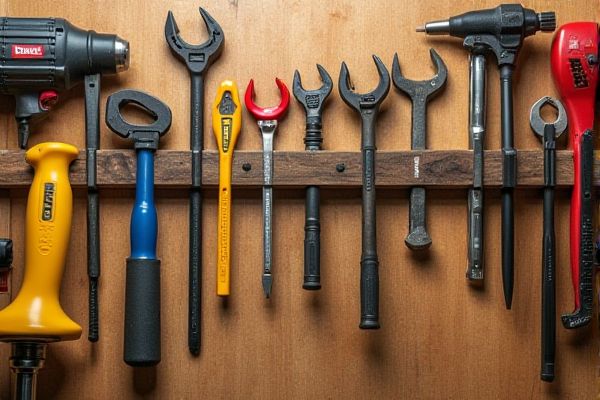
Horizontal tool organizers offer easy access and clear visibility of tools laid out in a single plane, ideal for quickly grabbing needed items during projects. Vertical tool organizers maximize storage space by stacking tools upright, making them perfect for compact areas or when floor space is limited; explore the rest of the article to determine which option suits your workspace and tool management style best.
Table of Comparison
| Feature | Horizontal Tool Organizers | Vertical Tool Organizers |
|---|---|---|
| Space Efficiency | Ideal for wide workbenches, spreads tools horizontally. | Saves floor space, stacks tools vertically. |
| Tool Visibility | Easy to see and access tools at a glance. | May require moving items to access lower tools. |
| Capacity | Suitable for a moderate number of tools. | Generally holds more tools due to vertical stacking. |
| Accessibility | Quick access to all tools placed side-by-side. | Access may be limited for tools at bottom levels. |
| Portability | Usually lighter and easier to move. | Can be bulky and heavier. |
| Best Use Case | Workbenches, small workshops, quick tool grab. | Large workshops, maximizing vertical space. |
Introduction to Tool Organization Solutions
Horizontal tool organizers maximize workspace efficiency by providing wide, flat storage that allows easy visibility and access to tools, ideal for workbenches and open areas. Vertical tool organizers save floor space by utilizing wall-mounted storage, keeping tools neatly arranged and accessible without cluttering your work surface. Choosing between horizontal and vertical options depends on your available space and workflow preferences to optimize your tool organization system.
Defining Horizontal and Vertical Tool Organizers
Horizontal tool organizers are storage units designed with compartments or drawers arranged side by side, allowing tools to be placed and accessed along a horizontal plane. Vertical tool organizers use upright structures such as pegboards, wall-mounted racks, or standing cabinets to store tools in a vertical alignment, maximizing space efficiency by utilizing height. The choice between horizontal and vertical organizers depends on workspace layout, tool size, and accessibility needs, with horizontal organizers offering easy drawer access and vertical organizers optimizing floor space.
Space Efficiency: Horizontal vs Vertical Organizers
Horizontal tool organizers maximize surface accessibility by laying tools side by side, ideal for workbenches with ample countertop space. Vertical tool organizers optimize limited floor space by storing tools upright, making them perfect for small workshops or garages with constrained areas. Your choice depends on balancing available space and ease of tool retrieval, with vertical options enhancing space efficiency and horizontal layouts improving visibility.
Accessibility and Convenience Comparison
Horizontal tool organizers offer easy visibility and quick access to tools laid out side-by-side, making them ideal for frequently used hand tools and small parts. Vertical tool organizers maximize storage space and improve organization by utilizing wall or cabinet height, allowing tools to be stored systematically and reducing clutter. Choosing between the two depends on available workspace and the user's preference for either immediate accessibility or space-efficient storage.
Tool Visibility and Inventory Control
Horizontal tool organizers provide clear visibility of your tools laid out side by side, making it easier to quickly identify and access each item. Vertical tool organizers maximize space by storing tools upright, which enhances inventory control through a compact, organized display that reduces clutter. Your choice between the two depends on whether you prioritize ease of visual access or space-efficient inventory management.
Portability and Mobility Differences
Horizontal tool organizers typically offer enhanced portability due to their low-profile design, making them easier to carry and fit into vehicle trunks or workbenches. Vertical tool organizers maximize mobility by saving floor space and providing quick access to tools in compact areas, ideal for workshops with limited room. The choice between horizontal and vertical organizers depends on the balance between transport convenience and efficient space utilization in a professional or DIY environment.
Customization and Expandability Options
Horizontal tool organizers typically offer extensive customization options through modular compartments and adjustable slots, making them ideal for users needing versatility in tool storage. Vertical tool organizers enhance expandability with stackable designs that maximize vertical space, allowing users to add layers or sections as tool collections grow. Both formats support personalized configurations, but horizontal organizers excel in compartmental flexibility while vertical organizers prioritize scalable storage capacity.
Durability and Material Considerations
Horizontal tool organizers often feature reinforced steel or heavy-duty plastic materials that provide robust durability and resistance to wear in high-traffic workshop environments. Vertical tool organizers commonly utilize metal alloys or reinforced polymers, optimizing space utilization while maintaining strength and longevity under frequent tool retrieval. Both types require corrosion-resistant coatings to withstand moisture, but horizontal organizers generally offer enhanced stability due to a lower center of gravity.
Best Use Cases for Horizontal Tool Organizers
Horizontal tool organizers excel in situations where you need quick, visual access to frequently used tools spread out over a wide workspace, making them ideal for workbenches or garage setups. Their design allows for efficient tool categorization and easy reach, which enhances productivity during detailed projects or repairs. If your tasks involve laying out tools side by side for sorting or assembling, a horizontal organizer will significantly streamline your workflow.
Best Use Cases for Vertical Tool Organizers
Vertical tool organizers are ideal for maximizing limited floor space in workshops and garages by utilizing wall areas efficiently. They are best suited for storing hand tools, power tools, and frequently accessed items, keeping them visible and easy to reach. Vertical organizers also enhance workspace ergonomics and help maintain an organized, clutter-free environment.
 homyna.com
homyna.com